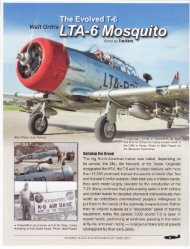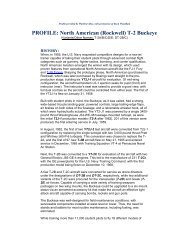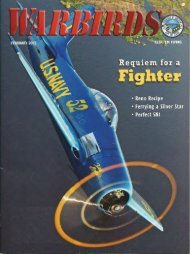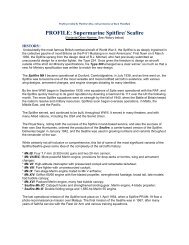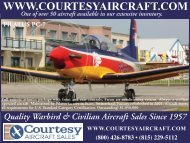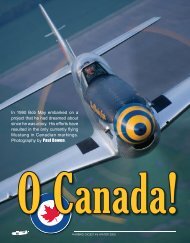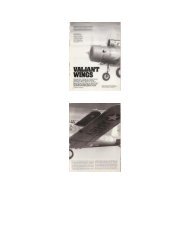To Read Sport Aviation's January 1990 Ed on the ... - Courtesy Aircraft
To Read Sport Aviation's January 1990 Ed on the ... - Courtesy Aircraft
To Read Sport Aviation's January 1990 Ed on the ... - Courtesy Aircraft
- No tags were found...
Create successful ePaper yourself
Turn your PDF publications into a flip-book with our unique Google optimized e-Paper software.
week or so Molt was back at L<strong>on</strong>g Beach for<br />
ano<strong>the</strong>r two years. The interesting thing<br />
about this little episode was that <strong>the</strong> pilot with<br />
whom Molt switched duty assignments was<br />
Joseph Kennedy, Jr., <strong>the</strong> older bro<strong>the</strong>r of<br />
later-to-be President John Kennedy. Joe<br />
Kennedy died during World War II while <strong>on</strong><br />
a top secret missi<strong>on</strong> against German fortificati<strong>on</strong>s.<br />
Shortly after arriving at L<strong>on</strong>g Beach <strong>the</strong><br />
first time, Molt had bought <strong>the</strong> paperwork for<br />
a wrecked 40 hp J-2 Cub and by purchasing<br />
<strong>the</strong> variou s airframe comp<strong>on</strong>ents from aircraft<br />
supply houses, built a new airplane<br />
around <strong>the</strong> old data plate. It was hardly a<br />
stock J-2 when he was finished, however.<br />
While still in college, Molt had become interested<br />
in radio and had somehow found<br />
<strong>the</strong> time to attend classes at <strong>the</strong> YMCA to<br />
prepare himself for taking <strong>the</strong> test to obtain<br />
his government radio license. It was this interest<br />
that, in part, induced him to transform<br />
his Cub into what was <strong>the</strong>n an IFR or "blind<br />
flying" trainer, complete with gyro instrumentati<strong>on</strong><br />
and a homebuilt radio capable of "riding<br />
<strong>the</strong> beam" of <strong>the</strong> AIN radio facilities <strong>the</strong>n<br />
in use for navigati<strong>on</strong>. Molt got his civilian instrument<br />
rating in this airplane . .. despite<br />
<strong>the</strong> fact that it was so heavy and so draggy<br />
with its wind driven generator and antennae<br />
that with two aboard, <strong>the</strong> poor little ol' 40<br />
horse C<strong>on</strong>tinental could hardly drag <strong>the</strong> thing<br />
above 2,000 feet!<br />
The "beam rider" radio had been designed<br />
and built as a collaborati<strong>on</strong> between Molt<br />
and an electr<strong>on</strong>ic whiz named Lester Ray.<br />
O<strong>the</strong>r pilots at L<strong>on</strong>g Beach saw it and began<br />
pestering Molt to build <strong>the</strong>m <strong>on</strong>e also, so he<br />
eventually decided to start a company to<br />
manufacture what he had already named <strong>the</strong><br />
Taylor Airph<strong>on</strong>e. There were commercially<br />
available aircraft radios for light planes in <strong>the</strong><br />
late 1930s, notably those developed by Bill<br />
Lear, but most were too expensive for owners<br />
of <strong>the</strong> smallest aircraft. Molt determined<br />
that his market niche should be a series of<br />
panel mount and portable aircraft radios for<br />
<strong>the</strong> low priced end of <strong>the</strong> private aircraft ownership<br />
spectrum, so after mustering out of<br />
<strong>the</strong> Navy in 1939, he set himself up in business<br />
as Taylor Airph<strong>on</strong>e Products and<br />
began manufacturing and marketing his<br />
radios.<br />
Unfortunately, Molt's career as an aircraft<br />
radio manufacturer was to be cut short by<br />
World War II. He was still in <strong>the</strong> Navy Reserve<br />
and in July of 1941 .. . with war obviously<br />
imminent even though Pearl Harbor<br />
was still half a year away ... he received <strong>the</strong><br />
call from Uncle Sam: Get your affairs in order<br />
and report to <strong>the</strong> Naval <strong>Aircraft</strong> Factory in<br />
Philadelphia ... in two weeks! His service<br />
record, he would later learn, that listed a<br />
background including engineering, radio and<br />
flying had caused him to be selected for what<br />
wou ld be <strong>on</strong>e of <strong>the</strong> more hush-hush programs<br />
of <strong>the</strong> war. Molt would spend <strong>the</strong> next<br />
five years developing dr<strong>on</strong>es and guided<br />
missiles .. . and <strong>on</strong> April 9, 1942 would become<br />
<strong>the</strong> first pers<strong>on</strong> to guide a surface-tosurface<br />
missile successfully to its target. In<br />
1943 top secret Project Gorg<strong>on</strong> was established<br />
to develop what we now call cruise<br />
missiles and Lt. Cdr. Molt Taylor was assigned<br />
as <strong>the</strong> project officer. Both turbojet<br />
and rocket Gorg<strong>on</strong> missiles were designed,<br />
built and flown . They differed from today's<br />
cruise missiles with <strong>the</strong>ir inertial guidance<br />
systems in that <strong>the</strong>y were c<strong>on</strong>trolled visually<br />
by means of a televisi<strong>on</strong> camera mounted in<br />
<strong>the</strong> vehicle . .. with <strong>the</strong> c<strong>on</strong>troller 20 or more<br />
miles away in a "mo<strong>the</strong>r ship" aircraft ...<br />
peering into a televisi<strong>on</strong> screen. Within days<br />
of <strong>the</strong> Japanese surrender in August of 1945,<br />
Molt was directing <strong>the</strong> first successful test<br />
flight of a turbojet powered Gorg<strong>on</strong> 111-B ...<br />
from a FM-2 Wildcat. Molt proved he could<br />
launch a Gorg<strong>on</strong> from under <strong>the</strong> wing of a<br />
PBY, guide it to its target .. . and still fly <strong>the</strong><br />
fighter. With every large aircraft thus a potential<br />
missile launcher, <strong>the</strong> loss of lives in c<strong>on</strong>venti<strong>on</strong>al<br />
bombing raids could have been<br />
dramatically reduced, because <strong>the</strong> fighter/<br />
launcher would <strong>on</strong>ly have to fly within c<strong>on</strong>trol<br />
range of its target, fire its missile(s) and<br />
stand off while guiding it right down a factory<br />
smokestack. For his work <strong>on</strong> <strong>the</strong> missile program,<br />
by <strong>the</strong>n Commander Molt Taylor was<br />
awarded this nati<strong>on</strong>'s Legi<strong>on</strong> of Merit ... and<br />
<strong>the</strong> Navy made a c<strong>on</strong>cerned effort to get him<br />
to commit to a career in <strong>the</strong> service and c<strong>on</strong>tinue<br />
his work.<br />
The atom bomb and <strong>the</strong> end of World War<br />
II changed every<strong>on</strong>e's plans, however. Many<br />
of <strong>the</strong> hundreds of thousands of suddenly<br />
released servicemen faced uncertain futures<br />
with quite a bit of trepidati<strong>on</strong> ... but not Molt.<br />
As always, he had a number of ir<strong>on</strong>s in <strong>the</strong><br />
fire and <strong>the</strong> <strong>on</strong>ly questi<strong>on</strong> was which <strong>on</strong>e of<br />
<strong>the</strong>m he would pull out. One of <strong>the</strong> projects<br />
he had worked <strong>on</strong> during <strong>the</strong> war was a small<br />
amphibian that was to be utilized as a dr<strong>on</strong>e.<br />
It was unique in that it had a low wing, with<br />
<strong>the</strong> wing roots serving as sp<strong>on</strong>s<strong>on</strong>s. He had<br />
recognized that <strong>the</strong> c<strong>on</strong>figurati<strong>on</strong> would<br />
make a great sportplane, so after his release<br />
from active duty in 1946, he and several<br />
o<strong>the</strong>rs formed a company to design and build<br />
such an aircraft ... almost entirely of magnesium.<br />
Called <strong>the</strong> Duckling, it had a nose<br />
and cabin secti<strong>on</strong> somewhat like a Seabee,<br />
but, of course, had <strong>the</strong> low wing .. . a ''floatwing",<br />
Molt called it.<br />
<str<strong>on</strong>g>To</str<strong>on</strong>g> produce <strong>the</strong> Duckling, a plant was<br />
needed and Uncle Sam's War Assets Administrati<strong>on</strong><br />
had plenty of those available for<br />
a few cents <strong>on</strong> <strong>the</strong> dollar. Molt and his group<br />
were <strong>the</strong> successful bidder for <strong>the</strong> Bellanca<br />
No. 2 Plant at New Castle, DE ... but were<br />
in for an unpleasant surprise when <strong>the</strong>y arrived<br />
to take it over. It turned out that water<br />
and road access to Plant No. 2 came through<br />
Bellanca Plant No. 1 .. . and <strong>the</strong> company<br />
was not about to aid a competitor in <strong>the</strong> postwar<br />
lightplane market. The deal fell through<br />
and <strong>the</strong> Duckling was not to be ... although<br />
<strong>the</strong> ''floatwing" c<strong>on</strong>figurati<strong>on</strong> would surface<br />
again years later in <strong>the</strong> form of Molt's popular<br />
amphibian, <strong>the</strong> Coot.<br />
The brief sojourn in New Castle was not<br />
totally in vain, however ... in fact, it would<br />
be a major turning point in Molt's life. While<br />
<strong>the</strong>re he chanced to meet inventor Robert E.<br />
Fult<strong>on</strong>, Jr. and became totally enamored with<br />
his roadable airplane, <strong>the</strong> Airphibian. For<br />
Molt <strong>the</strong> experience was much akin to a religious<br />
c<strong>on</strong>versi<strong>on</strong>. In a cognitive flash he<br />
simultaneously grasped <strong>the</strong> c<strong>on</strong>cept of <strong>the</strong><br />
vehicle, saw its portent for <strong>the</strong> future ... and<br />
realized that at last he had discovered his<br />
life's work. There is no zeal to surpass that<br />
of a pers<strong>on</strong> who believes he has found <strong>the</strong><br />
reas<strong>on</strong> for his existence, and if you have<br />
ever experienced <strong>the</strong> fervor with which Molt<br />
Taylor describes even <strong>the</strong> most superficial<br />
aspect of his Aerocar, you quickly realize just<br />
how complete, how all c<strong>on</strong>suming was his<br />
"c<strong>on</strong>versi<strong>on</strong>" that day 44 years ago.<br />
This was not to say, however, that Molt<br />
found no fault with <strong>the</strong> Airphibian. It was <strong>the</strong><br />
c<strong>on</strong>cept that had taken possessi<strong>on</strong> of his<br />
soul, not <strong>the</strong> machine, itself. Fult<strong>on</strong>'s car had<br />
to leave its wings and propeller at <strong>the</strong> airport<br />
to be driven <strong>on</strong> <strong>the</strong> highway ... which meant<br />
it had to return to that same airport to fly<br />
again. Molt saw a need for more utility. Remembering<br />
his experiences ferrying Luscombes<br />
and Culvers across <strong>the</strong> U. S., he<br />
envisi<strong>on</strong>ed a craft in which he could be flying<br />
al<strong>on</strong>g and up<strong>on</strong> encountering a fr<strong>on</strong>t, could<br />
land, fold <strong>the</strong> wings, hook <strong>the</strong>m up behind<br />
<strong>the</strong> car like a trailer and drive through to <strong>the</strong><br />
o<strong>the</strong>r side of <strong>the</strong> bad wea<strong>the</strong>r. Then, he<br />
could simply pull into <strong>the</strong> next airport,<br />
reinstall <strong>the</strong> wings and fly <strong>on</strong> to his destinati<strong>on</strong><br />
... and have an auto to drive to <strong>the</strong> very<br />
door of <strong>the</strong> pers<strong>on</strong> or firm he intended to<br />
visit. Such a vehicle, he believed, would revoluti<strong>on</strong>ize<br />
pers<strong>on</strong>al travel, increasing <strong>the</strong><br />
door to door speed over certain distances<br />
just as <strong>the</strong> auto had improved <strong>on</strong> <strong>the</strong> speed<br />
of <strong>the</strong> horse and buggy. In areas of <strong>the</strong> country<br />
without scheduled air service, <strong>the</strong>re<br />
would, in fact, be no faster means of going<br />
SPORT AVIATION 13



